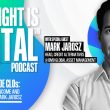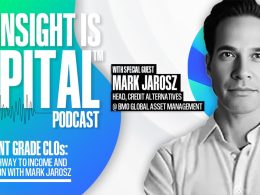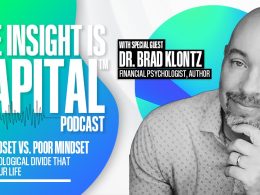"[Ray] Dalio tends to say you can have 16 uncorrelated return streams. That’s just categorically untrue." Mutiny Fund's Jason Buck doesn’t mince words. In a world where portfolio theory has been sanctified into gospel, Buck arrives as the heretic. The industry, he argues, has misled investors into believing their savings are investments—something they can gamble with in hopes of retirement on a sun-soaked beach. But savings aren’t investments; they are survival. And in markets where correlations tend to crash to one in liquidity events, Buck’s warning is more relevant than ever.
Offense, Defense, and the Illusion of Diversification
Most investors believe they are diversified. They aren’t.
“When March 2020 happens, all of your assets sell off at once, and that’s why we call them all offensive assets.” Buck dismantles the traditional portfolio pie chart, exposing its fatal flaw: it's just a house of cards built on long GDP, short volatility. In other words, portfolios today are designed for good times.
“[In our portfolios] We have half for offensive assets, half for defensive assets,” he explains. Stocks, bonds, private equity—offense. Commodity trend following? Uncorrelated. Long volatility and tail risk? Structurally negatively correlated—defense. Defensive assets. Most investors don’t hold enough of the latter.
Dalio’s "uncorrelated streams" narrative crumbles under Buck’s scrutiny. In a crisis, the true diversifiers are the ones that make money when everything else is falling apart. The real question is, do you have the self-awareness to recognize your own blind spots before it’s too late?
The Rodman Portfolio: The Unsung Hero of Stability
"I’m going to tell you about the greatest basketball player of all time from the Chicago Bulls…" Buck sets the trap.
Michael Jordan, right? Nope. Dennis Rodman.
Rodman, the lowest-scoring player in the Hall of Fame, was a statistical anomaly. "At his height, he was six standard deviations better than any other defensive rebounder in the league." He made everyone around him better. This is how Buck wants you to think about portfolio construction. The flashy stocks—your Jordans—grab the headlines. But without the Rodmans—long volatility, uncorrelated assets, anti-fragile plays—your portfolio is one bad break away from oblivion.
The Minnesota Vikings learned this the hard way. Trading for star running back Herschel Walker in 1989, they thought they were adding an MVP. Instead, the Cowboys flipped those picks into an 18-player haul that built a dynasty. Investing isn’t about one great trade. It’s about an ensemble that works together. The real winners are those who resist the impulse to chase flashy trades and instead cultivate patience, foresight, and discipline.
The Mirage of Uninterrupted Growth
Everyone wants to believe in America’s perpetual outperformance. Buck doesn’t buy it.
"I’d love to believe in American exceptionalism, but I can’t help the little voice in the back of my head going, you know, we’re not that special. If it can happen anywhere, it can also happen to us."
History doesn’t repeat, but it sure does rhyme. Japan’s lost decades. Europe’s stagnation. The illusion of uninterrupted US market dominance could one day unravel. "Even 60/40 portfolios have been underwater for twenty years in some countries," Buck points out. "Italy from 1960-1980, negative 72%. Spain, negative 59%."
Yet investors pile into US stocks, convinced that past performance guarantees future results. It’s the cognitive equivalent of believing that ice baths create billionaires—mistaking correlation for causation. The capacity to step back and critically evaluate your assumptions is an emotional intelligence trait many investors lack, to their own detriment.
Ergodicity: The Fatal Flaw in Your Retirement Plan
What’s the biggest mistake investors make? Believing in averages.
"The industry treats markets as ergodic systems," Buck explains. "But they’re not."
Most investors plan their financial futures assuming a 7% CAGR (compounded annual growth rate). But compounding doesn’t work that way. Averages mislead. "If your path doesn’t line up with the ensemble average, you’re in a non-ergodic system," Buck warns. In plain English: if you hit the wrong sequence of returns, you go broke before you ever reach the long-term average.
One solid historical illustration of this concept can be summed up by comparing how investors in a fund perform vs. the fund itself. Take Fidelity Magellan Fund, for instance–it averaged a 29% annual return under Peter Lynch's 13-year run, however, many investors lost money because their individual outcomes depended on when they entered and exited the fund—showing that individual trajectories (investor behavior) did not align with the fund's overall average performance.
Imagine a gambler with a winning strategy. Every day, they make 50% on their money, but once every 28 days, they lose everything. The expected return is still positive. But in reality, they are doomed. That’s the problem with market returns—an average 7% means nothing if your personal sequence includes a 50% drawdown right before retirement.
The lesson? "Portfolio diversification isn’t just about expected returns—it’s about survival," Buck says. The game isn’t to maximize returns. It’s to ensure you live to see them. And that requires emotional resilience—the ability to accept uncertainty, manage risk, and control knee-jerk reactions to market swings.
The Market Doesn’t Care About Your Plans
"Only a fool trips on what is behind them," Buck quips. Past performance may be comforting, but it’s not predictive. The market isn’t going to reward you for believing in American exceptionalism, for trusting that the Fed has your back, or for assuming that buying the dip always works. It’s a system that punishes ignorance, slowly at first, then all at once.
Diversify intelligently. Hold assets that zig when others zag. Build a team, not a superstar portfolio. And above all, stop thinking about your savings as an investment.
Or don’t. The market doesn’t care. But you should, because your ability to navigate uncertainty with self-awareness and discipline may be the only thing standing between you and financial ruin.
Copyright © AdvisorAnalyst
















